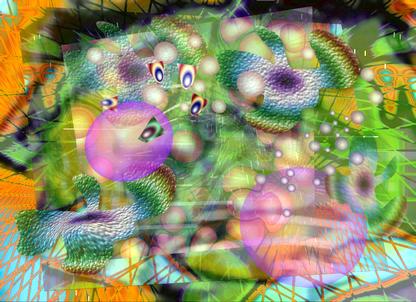
Swiggle And Swaggle: Copyright (C) 1998 Greg Jalbert
Generative Art: An exploration of meaning
Greg Jalbert: March 1998
One might define generative art as art where the main technique of development within a piece or series of pieces is an evolutionary process, like biological or physical evolution, or the evolution of ideas. This might mean that the intent of the work is to make evolution the primary message. Evolution involves a complex process of development with many possible influences. Much of art involves generative processes of development, selection of work for various reasons. These reasons include everything from emotional impact, to beauty, to commercial appeal, to personal fullfillment, to social propaganda, and more.
What is NOT generative art? Perhaps it is art that has other types of messages as the primary intent, such as art dealing with universal human issues, political art, or decorative art. Is there a specific function of generative art? It could be that the intent of generative art is to make people more aware of evolution. Genetic histories in DNA is one form of coding attributes and behaviours, but we also find there are cultural systems of encoding history, and perhaps other unseen connections between organisms living in communities that contain codes of attributes and behaviour. Perhaps this is simply the written and oral categories of tradition. Is the generative in in art part of the message, or the technique?
History and science provide many answers to questions of viability of various systems. In the art world, these answers tip the balance in unexpected ways. Does generative art select for survival? or beauty, or synergy? Does it evolve more than any other art? One could examine the history of visual arts and see threads of influence, techniques of image making that work in a universal timeless way, and other images that may only have a temporary impact, later becoming meaningless or unfavorable.
It seems that 'generative art' is a different thing from 'generative' art. Buzzwords? Restrictive labels? Informative classifications?
In painting on canvas, an artist might be working from a sketch or a preconceived plan, or the process of painting may be somewhat or entirely improvisatory. The plan may be a conceptual one, determining something other than the position, color, etc. of the marks actually made. In the improvisational mode, the generative process can be a useful mode, aiding the development of textures and populations of brushstrokes. While a computer is powerful tool for generative art, it still seems that the mind is more easily reconfigured to change paradigms in the process of painting. Ideally, all existing and imagined software would be available at the computer artist's momentary whim, so as to easily visualize the brilliant flashes of inspiration. This is not often the case. We wait for the slow computer to render, and wish that our software had more features yet was easier to use. The areas of generative art might really come to fruition on the computer when the boundaries between software file formats and methods of interaction disappear. Does this mean our software must evolve towards the monolithic? Perhaps, the ecosystem provides a better model, with it's complex interactions between many levels of 'organisms'. Maybe generative art only exists because we realize there is no better model on which to map the complexity of our creations. Humans... quite a bizarre abberation in the universe, or so it seems so far. Are we trying to reinvent the universe with all of our science projects?
One of the satisfying experiences of generative art is that we get to see new shapes, new 'organisms', that we have never seen. It is like walking through a strange land where everything is a delight to the eye. What is it? What does it do? How does it work? Why is it like that? While this newness is fascinating, where does it lead? The joy of discovery may also be a lust for new information. What do we need this information for? We forget the peace of simplicity, and the fascinating world of reality. Travel in the physical realm takes a lot of energy, so the relatively effortless mode of exploring the world through art, recording and broadcast media provides us with a much wider scope of experience. So generative art, in the forms propagated by software authors and users, can offer a potentially vast population of forms, virtual creatures.
There seems to be generative art that operates outside of the visual realm. Music is one of these, but there is also a conceptual art that evolves. It's kind of a composition or improvisation of ideas. A composition might be defined as a piece that has fenced itself off from outside influence, a monologue of the composer. It is a solid item. An improvisation, on the other hand, is something that allows outside elements to determine the course of a line, a melody, or a conversation.
Evolution seems to operate at different levels: inside a composition, outside a composition in a composer's body of work, and in a movement or community of art. It's good to step back and see it all from the outside, and then again to see it from inside one of the tiniest elements.
For more, visit the imaja web site at http://www.imaja.com and tonecolor at http://www.imaja.com/site/tonecolor/.
The painting above was created by Greg Jalbert with Imaja Bliss Paint software and Fractal Design Painter software. |